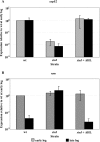Role of quorum sensing in Sinorhizobium meliloti-Alfalfa symbiosis
- PMID: 19395488
- PMCID: PMC2698488
- DOI: 10.1128/JB.00376-09
Role of quorum sensing in Sinorhizobium meliloti-Alfalfa symbiosis
Abstract
The ExpR/Sin quorum-sensing system of the gram-negative soil bacterium Sinorhizobium meliloti plays an important role in the establishment of symbiosis with its host plant Medicago sativa. A mutant unable to produce autoinducer signal molecules (sinI) is deficient in its ability to invade the host, but paradoxically, a strain lacking the quorum-sensing transcriptional regulator ExpR is as efficient as the wild type. We compared the whole-genome expression profile of the wild-type strain with strains missing one of the quorum-sensing regulatory components to identify genes controlled by the ExpR/Sin system throughout the different phases of the bacterial growth cycle, as well as in planta. Our analyses revealed that ExpR is a highly versatile regulator with a unique ability to show different regulatory capabilities in the presence or absence of an autoinducer. In addition, this study provided us with insight into the plant invasion defect displayed by the autoinducer mutant. We also discovered that the ExpR/Sin quorum-sensing system is repressed after plant invasion. Therefore, quorum sensing plays a crucial role in the regulation of many cell functions that ensures the successful invasion of the host and is inactivated once symbiosis is established.
Figures






Similar articles
-
ExpR coordinates the expression of symbiotically important, bundle-forming Flp pili with quorum sensing in Sinorhizobium meliloti.Appl Environ Microbiol. 2014 Apr;80(8):2429-39. doi: 10.1128/AEM.04088-13. Epub 2014 Feb 7. Appl Environ Microbiol. 2014. PMID: 24509921 Free PMC article.
-
The ExpR/Sin quorum-sensing system controls succinoglycan production in Sinorhizobium meliloti.J Bacteriol. 2007 Oct;189(19):7077-88. doi: 10.1128/JB.00906-07. Epub 2007 Jul 20. J Bacteriol. 2007. PMID: 17644606 Free PMC article.
-
Regulation of motility by the ExpR/Sin quorum-sensing system in Sinorhizobium meliloti.J Bacteriol. 2008 Feb;190(3):861-71. doi: 10.1128/JB.01310-07. Epub 2007 Nov 16. J Bacteriol. 2008. PMID: 18024512 Free PMC article.
-
Rhizobium meliloti exopolysaccharides: synthesis and symbiotic function.Gene. 1996 Nov 7;179(1):141-6. doi: 10.1016/s0378-1119(96)00322-8. Gene. 1996. PMID: 8955640 Review.
-
Inter-kingdom signaling: chemical language between bacteria and host.Curr Opin Microbiol. 2009 Apr;12(2):192-8. doi: 10.1016/j.mib.2009.01.006. Epub 2009 Mar 21. Curr Opin Microbiol. 2009. PMID: 19318290 Free PMC article. Review.
Cited by
-
Identification of direct transcriptional target genes of ExoS/ChvI two-component signaling in Sinorhizobium meliloti.J Bacteriol. 2009 Nov;191(22):6833-42. doi: 10.1128/JB.00734-09. Epub 2009 Sep 11. J Bacteriol. 2009. PMID: 19749054 Free PMC article.
-
Regulation Mediated by N-Acyl Homoserine Lactone Quorum Sensing Signals in the Rhizobium-Legume Symbiosis.Genes (Basel). 2018 May 18;9(5):263. doi: 10.3390/genes9050263. Genes (Basel). 2018. PMID: 29783703 Free PMC article. Review.
-
Quorum Quenching Activity of the PGPR Bacillus subtilis UD1022 Alters Nodulation Efficiency of Sinorhizobium meliloti on Medicago truncatula.Front Microbiol. 2021 Jan 15;11:596299. doi: 10.3389/fmicb.2020.596299. eCollection 2020. Front Microbiol. 2021. PMID: 33519732 Free PMC article.
-
Isovaleryl-homoserine lactone, an unusual branched-chain quorum-sensing signal from the soybean symbiont Bradyrhizobium japonicum.Proc Natl Acad Sci U S A. 2011 Oct 4;108(40):16765-70. doi: 10.1073/pnas.1114125108. Epub 2011 Sep 26. Proc Natl Acad Sci U S A. 2011. PMID: 21949379 Free PMC article.
-
Water-Soluble Humic Materials Regulate Quorum Sensing in Sinorhizobium meliloti Through a Novel Repressor of expR.Front Microbiol. 2018 Dec 21;9:3194. doi: 10.3389/fmicb.2018.03194. eCollection 2018. Front Microbiol. 2018. PMID: 30627123 Free PMC article.
References
-
- Bahlawane, C., M. McIntosh, E. Krol, and A. Becker. 2008. Sinorhizobium meliloti regulator MucR couples exopolysaccharide synthesis and motility. Mol. Plant-Microbe Interact. 211498-1509. - PubMed
-
- Barnard, A. M., and G. P. Salmond. 2007. Quorum sensing in Erwinia species. Anal. Bioanal. Chem. 387415-423. - PubMed
Publication types
MeSH terms
Substances
Grants and funding
LinkOut - more resources
Full Text Sources
Molecular Biology Databases

